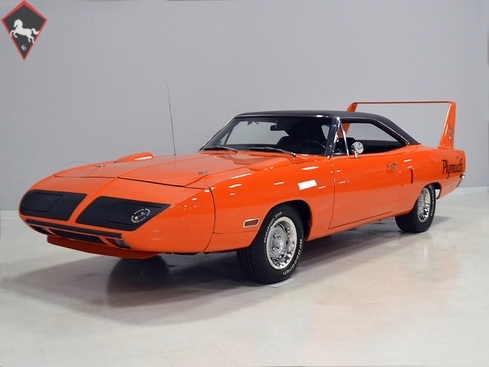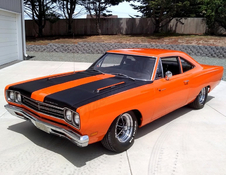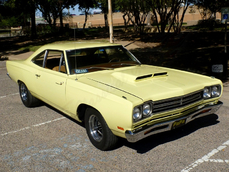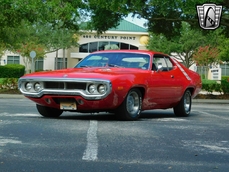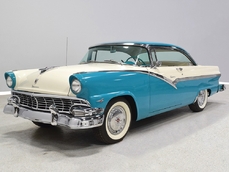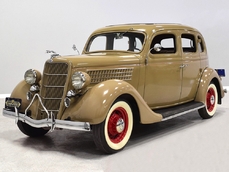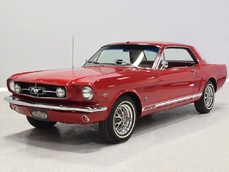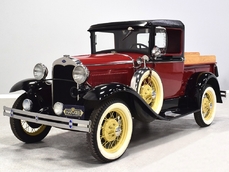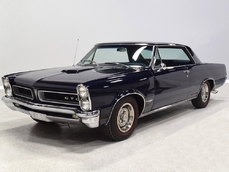Plymouth Roadrunner 440 cubic inch V8 1970
Allgemeine Beschreibung :
Homologation: The process by which auto manufacturers submit detailed specifications of a production car to an appropriate regulating body, along with the assertion that the requisite number of production cars have been offered to the public for sale.
In short, if you want to race it, you need to let the public buy it.
There has likely never been a homologation special as radical and indifferent to convention as Chrysler’s “winged warriors,” the Dodge Daytona and Plymouth Superbird. Built with the goal of going 200 MPH on the high banks of the NASCAR circuit, they were single-minded in their pursuit of speed and Chrysler execs didn’t care if any were sold to John Q. Public. Winning, that’s what the wing cars were all about, everything else was secondary. And it worked—they were the first NASCAR racers to go more than 200 MPH on the track; so fast, in fact, that multiple complaints from the competition resulted in the winged warriors being banned from competition after just one year.
Of course, they were virtually impossible to sell to the public in 1970—they were not only wild to look at, but they were wildly expensive with a $4298 base price (a comparable 440-powered Road Runner started at about $3100). If you were a regular guy with a regular job, you certainly weren’t buying something like this Vitamin-C Orange 1970 Plymouth Road Runner Superbird to commute to work. There are reports that some were still sitting on dealer lots in 1972, with a few dealers even removing the nose cone and wing to make them look a little more conventional. Nevertheless, they have become some of the most iconic Mopar muscle cars of all time and there has never been a production car more dedicated to form following function.
OK, that’s a lot of words, but this is a lot of car. It’s impossible to go unnoticed when you drive this Superbird, and it’s not just because of the towering rear wing. Restored to original specs, it wears vivid Vitamin-C Orange paint, which was one of seven original choices and it was indeed this car’s original color. These cars can be devilishly difficult to restore properly given all the hand work and unique parts that went into their construction, and faking one is virtually impossible. It appears that this one is wearing all its original sheetmetal, including quarters and floors, and unlike many of its siblings, it seems to have always been treated as something special, not some oddball throwaway. It is likely far better than it was when it was new, particularly in the fit of the nose cone, which conforms to the Road Runner’s front fenders far better than it did originally. The headlight doors fit well (and flip up properly when you hit the switch), and even the wonky hood extension sits relatively flush with the fenders. There’s no way those guys at the factory were being this careful. The paint is vivid and deep, with a gloss that was all but impossible in 1970, so it’s surely modern two-stage urethane. It's also worth noting that all the Superbirds came standard with vinyl roofs, which were there to cover the ridiculously crude bodywork used to install the flush-fitting rear window, which involved a fiberglass plug and lots of filler. And while that towering wing looks fragile, it’s actually made from high-grade aluminum and attached with struts connected to the subframe that are strong enough to support a grown man sitting on top.
There’s not much chrome, but there are plenty of cool details, starting with a smattering of Road Runner decals that add a bit of whimsy. There are shiny hood pins up front that are probably mandatory on a car this fast, and those scoops atop the front fenders were purely stylistic on the street cars but functional on the race cars, providing air extraction for the front fenders as well as clearance for the tires at full jounce. Big PLYMOUTH billboards on the quarters were appropriate for a car destined for NASCAR ovals and this car includes an optional ($6.85) passenger-side mirror. And all of it remains in excellent condition.
There were only two colors you could get inside, black or white, which this car carrying basic black with some handsome silver piping on the seats. And while it was based on the no-frills Road Runner, it’s actually quite nicely detailed inside, with deeply sculpted high-back buckets, door panels with plenty of bright trim, and a wood-paneled center console that warms things up a bit. The woodgrained wheel was also optional, as were the Rallye gauges and Tick-Tock-Tach, which is fully operational. Black carpets are protected by embroidered floor mats that seem appropriate, and there’s an AM/FM radio in the dash, which was pretty high-tech in 1970. The gauges are all rebuilt with crisp, bright markings and the vitals always look healthy. A few more Roadrunner emblems, seat belts, and a taut headliner round it out. The trunk opens conventionally (the wing is exactly high enough to clear the trunk lid) and inside you’ll find a correct mat, jack assembly, and what might just be the original spare tire. You’ll also note that correct markings have been duplicated under the lid, along with a set of reproduction jack decals.
This car originally carried a 440 cubic inch V8 with a 4-barrel carburetor (the Super Commando), rated at 375 horsepower. However, it has been upgraded with a correct Six-Pack induction system with three 2-barrel carburetors and 390 horsepower. We believe it is a warranty replacement block, and if you study the stamping pad, you will see there is no VIN stamp at all, adding evidence for this theory (if this engine came from another car, there would be another car's VIN stamped in the center of the pad). It’s date-code correct, being built on June 10, 1969 (all Superbirds were built between September and November, 1969) and features a correct F440 stamping denoting a 1970 model year 440, as well as the HP2 stamping indicating it was a high-performance engine. It is a correct 2536430 casting. There is no VIN stamping on the oil pan rail. It was fully rebuilt to mostly stock specs save for a slightly upgraded camshaft and the aforementioned Six-Pack carburetors. It runs superbly, starting easily and idling well after about a minute of warm-up time, and you’d better believe there’s plenty of power on tap. You can feel the detent in the throttle where the outer carburetors start to open, and if you push through that, the winged warrior lunges forward with an effortless surge of torque. We’re not sure how effective the aero enhancements are on a street car, but we’re sure glad they’re there!
The engine bay was properly detailed at the time of restoration, with Hemi Orange paint on the block that’s pretty darned close to the Vitamin-C bodywork and the air cleaner assembly is correct with a reproduction decal. Properly stamped hoses and spring-style clamps were used throughout and even the distributor cap is an accurate reproduction unit. The plug wires are the only notable non-original part, but that’s easy enough to fix if you’d like to put this car back on the show field. Power steering and power front disc brakes were standard on the Superbird, with this car also carrying a proper red-cap battery and anti-freeze warning tag for that last bit of authenticity.
The transmission is a TorqueFlite 3-speed automatic feeding an 8.75-inch rear end with standard 3.55 gears inside, a great combination that makes for punchy acceleration but relaxed cruising at speed. The undercarriage is highly detailed with beautifully finished floors, a correct reproduction dual exhaust system, and new lines and hoses for the brake system. It does show some minor signs of use (the restoration has about 12,000 miles on it), but there’s absolutely no evidence that this car was ever rusty or wrecked and the detailing underneath suggests it’s never even been wet since the restoration was completed. The ride is surprisingly supple and smooth, the brakes are sufficient, and the steering is typically over-boosted, but that’s how these cars were when they were new. However, we can promise that the driving experience is never, ever boring. 15-inch Rallye wheels were optional, with these carrying staggered 225/70/15 front and 275/60/15 rear BFGoodrich T/A radials that look fantastic in the big wheel arches.
Documentation includes the original owner’s manual, restoration photos, and a stand-up poster detailing the car’s specifications and history. It also includes the original 4-barrel Carter carburetor, air cleaner assembly, and intake manifold.
These are just incredibly cool cars that will never be duplicated again. Sure, there are still homologation specials being built by manufacturers all over the world, but none with the take-no-prisoners attitude of the Superbird. With only 1935 being built (15 more than necessary to homologate the car), these are incredibly rare cars, and experts estimate that only about 1000 still exist today. This is number 330, making it a fairly early production car. The restoration is beautiful, it’s fully sorted, and you’ll always cause a stir when you arrive in a wing car. Call today!
http://www.harwoodmotors.com/vehicles/inventory_details.php?id=828
1970 Plymouth Roadrunner 440 cubic inch V8 is listed verkauft on ClassicDigest in Macedonia by for $129900.
Fakten der Auto
Karosserietyp : Auto Marke : Plymouth Modell : Roadrunner Ausführung : 440 cubic inch V8 Hubraum : 0.0 Modelljahr : 1970 Lage : Ohio
Verkauft
Angaben Zum Verkäufer
Verkauft
People who viewed this Plymouth Roadrunner also viewed similar Plymouth listed at ClassicDigest
Other cars listed for sale by this dealer
über Plymouth
Die Marke Plymouth hatte von Anfang an einen erheblichen Einfluss auf die Automobilindustrie bis zu ihrer letztendlichen Absendung. Hier ist ein Überblick über Plymouth, der seine Geschichte, bemerkenswerte Modelle und Spezifikationen abdeckt:Frühe Jahre und Stiftung:
Origins (1928): Plymouth wurde von der Chrysler Corporation als erschwingliche Marke mit mittlerer Ebene vorgestellt, die sich auf budgetbewusste Verbraucher zielte.
Erfolgsfaktoren: Aufgrund seiner zuverlässigen Technik, Erschwinglichkeit und cleveren Marketingkampagnen erlangte es Beliebtheit.
Bemerkenswerte Modelle:
Plymouth Road Runner (1968-1980):
Ikone Muscle Car: Bekannt für seine Leistung, Erschwinglichkeit und minimalistisches Design.
Spezifikationen: Bieten Sie verschiedene V8 -Motoroptionen mit Strom von 335 bis 390 PS an.
Plymouth Barracuda (1964-1974):
Muscle Car -Konkurrent: positioniert als sportlicher Konkurrent im Muscle Car -Segment.
Spezifikationen: Die Motoroptionen umfassten V8s mit Ausgangsleistung zwischen 145 und 425 PS.
Plymouth Fury (1955-1978):
Langlebigkeit: Eines der am längsten produzierten Modelle von Plymouth, die in verschiedenen Körperstilen erhältlich ist.
Technische Funktionen: Motoroptionen umfassten V8s mit Strom von 215 bis 375 PS.
Plymouth Valiant (1960-1976):
Kompaktes Auto: Eingeführt als kompaktes Auto, bekannt für seine Haltbarkeit und Zuverlässigkeit.
Motorspezifikationen: Inline-Six- und V8-Motoren mit Strom von 100 bis 235 PS.
Niedergang und Niedergang:
Spätere Jahre: Plymouth stand vor Herausforderungen aufgrund der Markenverdünnung innerhalb der Chrysler Corporation und dem zunehmenden Wettbewerb durch andere Marken.
Abbruch: Die Marke hatte in den neunziger Jahren zu kämpfen, da die Unternehmensumstrukturierung und der sinkende Umsatz zurückgegangen sind. Plymouth stellte 2001 im Rahmen von DaimlerChryslers Straffungsbemühungen die Produktion ein.
Vermächtnis und Auswirkungen:
Plymouths Vermächtnis liegt in seinen Beiträgen zur amerikanischen Automobillandschaft und bietet zuverlässige, erschwingliche und stilvolle Fahrzeuge. Während es in seinen späteren Jahren Herausforderungen stand und letztendlich die Produktion einstellte, bleiben einige seiner ikonischen Modelle, insbesondere diejenigen in der Muscle -Car -Ära, unter Sammlern und Enthusiasten und hinterlassen eine dauerhafte Marke für die Automobilgeschichte.
